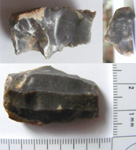Flint blade

Click ^ for larger image.
This Neolithic flint blade dates to between around 4000 BCE to 2500 BCE, the time of the first farmers. It was struck from a carefully prepared nodule that had been shaped to have a roughly flat surface called a striking platform. By hitting the edge of this platform with another stone (or other tough implement such as an antler) at just the right angle, a sliver of flint is detached from the core. With skill and a little luck, this sliver will be a useful blade with two edges.
The parallel lines are scars left by other, smaller blades being struck off. By continually working around the outside of the core (which becomes somewhat cylindrical in the process), a single nodule of flint can produce dozens of razor-sharp blades (each analogous to a modern penknife).
Material: stone
Period: Stone Age
Find spot: 35 West Town Park, Brislington, Bristol. ST 61806996
Exhibit contributed by Jonathan Rowe
Text written by Ken Taylor, in 2011
Photographer: Ken Taylor
Acquisition number: 110730a1